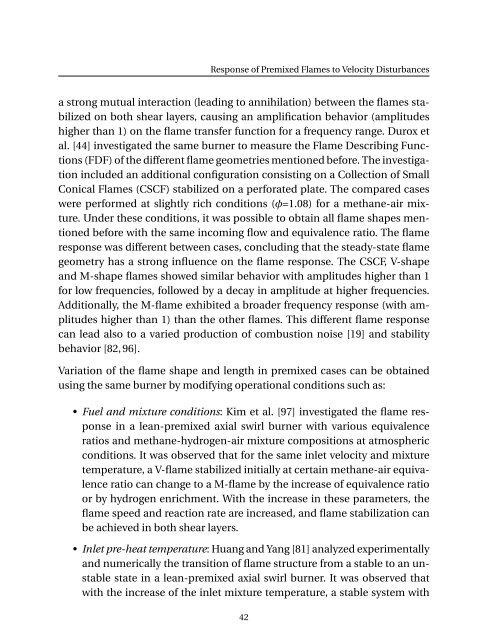Numerical Simulation of the Dynamics of Turbulent Swirling Flames
Numerical Simulation of the Dynamics of Turbulent Swirling Flames
Numerical Simulation of the Dynamics of Turbulent Swirling Flames
You also want an ePaper? Increase the reach of your titles
YUMPU automatically turns print PDFs into web optimized ePapers that Google loves.
Response <strong>of</strong> Premixed <strong>Flames</strong> to Velocity Disturbances<br />
a strong mutual interaction (leading to annihilation) between <strong>the</strong> flames stabilized<br />
on both shear layers, causing an amplification behavior (amplitudes<br />
higher than 1) on <strong>the</strong> flame transfer function for a frequency range. Durox et<br />
al. [44] investigated <strong>the</strong> same burner to measure <strong>the</strong> Flame Describing Functions<br />
(FDF) <strong>of</strong> <strong>the</strong> different flame geometries mentioned before. The investigation<br />
included an additional configuration consisting on a Collection <strong>of</strong> Small<br />
Conical <strong>Flames</strong> (CSCF) stabilized on a perforated plate. The compared cases<br />
were performed at slightly rich conditions (φ=1.08) for a methane-air mixture.<br />
Under <strong>the</strong>se conditions, it was possible to obtain all flame shapes mentioned<br />
before with <strong>the</strong> same incoming flow and equivalence ratio. The flame<br />
response was different between cases, concluding that <strong>the</strong> steady-state flame<br />
geometry has a strong influence on <strong>the</strong> flame response. The CSCF, V-shape<br />
and M-shape flames showed similar behavior with amplitudes higher than 1<br />
for low frequencies, followed by a decay in amplitude at higher frequencies.<br />
Additionally, <strong>the</strong> M-flame exhibited a broader frequency response (with amplitudes<br />
higher than 1) than <strong>the</strong> o<strong>the</strong>r flames. This different flame response<br />
can lead also to a varied production <strong>of</strong> combustion noise [19] and stability<br />
behavior [82, 96].<br />
Variation <strong>of</strong> <strong>the</strong> flame shape and length in premixed cases can be obtained<br />
using <strong>the</strong> same burner by modifying operational conditions such as:<br />
• Fuel and mixture conditions: Kim et al. [97] investigated <strong>the</strong> flame response<br />
in a lean-premixed axial swirl burner with various equivalence<br />
ratios and methane-hydrogen-air mixture compositions at atmospheric<br />
conditions. It was observed that for <strong>the</strong> same inlet velocity and mixture<br />
temperature, a V-flame stabilized initially at certain methane-air equivalence<br />
ratio can change to a M-flame by <strong>the</strong> increase <strong>of</strong> equivalence ratio<br />
or by hydrogen enrichment. With <strong>the</strong> increase in <strong>the</strong>se parameters, <strong>the</strong><br />
flame speed and reaction rate are increased, and flame stabilization can<br />
be achieved in both shear layers.<br />
• Inlet pre-heat temperature: Huang and Yang [81] analyzed experimentally<br />
and numerically <strong>the</strong> transition <strong>of</strong> flame structure from a stable to an unstable<br />
state in a lean-premixed axial swirl burner. It was observed that<br />
with <strong>the</strong> increase <strong>of</strong> <strong>the</strong> inlet mixture temperature, a stable system with<br />
42
















